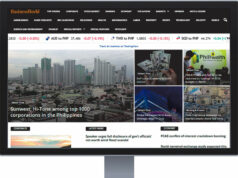A global path yielding towards recovery

By Chelsey Keith P. Ignacio, Special Features Writer
EVEN BEFORE the coronavirus disease 2019 (COVID-19) pandemic began to plague industries from the past year, significant issues such as the financial crisis of 2008-2009 and the ongoing trade and tariff tensions had impacted manufacturing.
By early 2020, when the pandemic limited business operations and closed international borders, critical impacts were felt on the manufacturing sector. China and other East and Southeast Asia countries experienced the effects by the first quarter while the rest of the world recorded production losses in the second and third quarters.
A year over in the COVID-afflicted world, global manufacturing production is on its path to recovery in the first quarter of 2021, according to the latest United Nations Industrial Development Organization (UNIDO) quarterly manufacturing report. The speed of recovery, however, varies on country and industry groups.
After the 6.8% drop in the manufacturing output due to the early impacts of COVID-19 a year ago, UNIDO recorded an annual output growth of 12.0% in the first quarter of the current year.
In the industrialized economies, the agency reported a 1.5% growth in the said quarter compared to the same period of 2020 when viewed at a glance. But looking more closely, not all countries have seen an increase based on their manufacturing outputs.
Year over year, the Northern American region still declined by 0.6%. Yet in the previous quarter, it recorded a 2.8% drop. “This development is primarily linked to the manufacturing activity in the United States, where output fell by 0.6% and 2.6% in the last two quarters, respectively,” UNIDO’s report read.
Meanwhile, manufacturing outputs of industrialized economies in the Asia and Pacific (APAC) region have surpassed their production levels before the pandemic, recording an increase of 2.7% in the first quarter of 2021.
Although Japan, the region’s largest manufacturer, has recorded a 1.3% output reduction in the said quarter, the growth figures of Taiwan (13.6%), Singapore (9.7%), and the Republic of Korea (5.6%) have counterweighed the decline. Such a significant rise in output is attributable to the positive performance of the computer and electronics, and the pharmaceutical industries.
Industrialized countries in Europe also increased their manufacturing production by 2.6% in the first quarter of 2021. Ireland notably registered two-digit growth rates for the last two quarters. Italy, France, and Spain grew their outputs by 9.0%, 1.7%, and 1.5%, respectively. Germany, however, has a decreased output of 1.8%.
The United Kingdom, now a non-European Union (EU) industrialized economy, has an output drop of 1.6% in the same quarter, following its 2.7% decline in the previous quarter. “Uncertainties regarding Brexit and the future relationship between the United Kingdom and the EU persist and could affect the performance of the country’s manufacturing sector in the post-pandemic era,” UNIDO noted.
Somehow akin to the industrialized economies, developing and emerging industrial countries also logged indications of recovery in their manufacturing productions at varying rates in the first quarter of 2021, as shown on the group’s 3.2% increase. This figure does not include the outputs from China, the largest manufacturer globally.
UNIDO’s statistics presented China separately due to its size and specific characteristics of its economy. “Sustained high growth rates over the past several years have rapidly been transforming China into an industrialized economy,” the organization said.
In the latest seasonally adjusted figures, China’s manufacturing sector, including most of its industries, reported a year-over-year increase rate of 38.2% during the first quarter of 2021. “It remains uncertain, however, in what direction China’s export-oriented manufacturing sector will continue to develop in the context of dynamic domestic activity and subdued international demand,” UNIDO also noted.
Looking at the other developing and emerging industrial countries in the APAC region, a 2.5% year-over-year increase in manufacturing output is shown in the first quarter of this year. But a closer observation manifested the differences in the production among the countries. As examples, India, Turkey, and Vietnam saw a 5.5%, 12.7%, and 7.6% growth, respectively. In Indonesia, however, the rate decreased by 1.5%.
Likewise, the output growth in European developing and emerging industrial economies differed from country to country. The group generally accumulated a 1.9% year-over-year increase, with Greece, Romania, and Croatia experiencing output growths of 2.5%, 2.8%, and 5.0%, respectively. But decreases occurred in the Republic of Moldova by 3.0% and in Ukraine by 5.4%.
In the same period, the Latin American region also experienced a 5.4% increase when compared year over year. “It remains unclear whether this is a sign of sustainable stabilization, considering the sluggish growth trends that have been observed in this country group since 2018,” UNIDO added.
The activities in Mexico and Brazil, the two largest manufacturers of the region, made respective 0.4% and 6.6% output rates. An increase in outputs also showed in Argentina (11.7%), Colombia (6.6%), and Costa Rica (4.7%). Chile, the group’s only industrialized country, experienced a 0.5% rise in a year-over-year comparison.
Meanwhile, by the growth estimates based on the limited available data, a slight increase of 0.8% showed in the African region, compared to the first quarter of 2020. Senegal, Rwanda, Nigeria, and Tunisia increased their manufacturing productions by 12.9%, 9.9%, 2.7%, and 2.0%, respectively.
Such varying growth among country groups, UNIDO continued, showed on the industrial groups based on technological intensities.
“In addition to the COVID-19 crisis in 2020, pre-pandemic uncertainties related to rising trade restrictions had a major influence on producers, leading to a gradual slowdown since 2018, albeit with varying impacts in different industrial sectors,” the organization explained.
In 2020, UNIDO recorded output decreases of at least 5% in the first quarter and exceeding 10% in the second quarter.
By the first quarter of 2021, medium-high- and high- as well as medium-low-technology industries experienced faster recovery with output growth of at least 10%. The medium high- and high-technology industries significantly gained a 16.8% rise. The low-technology industries, meanwhile, have seen a year-over-year 5.8% growth rate.
UNIDO also reported that in all country groups, the majority of the industries such as computer and electronics, electrical equipment, rubber, and plastic, as well as chemical products seen remarkable growth in the first quarter of 2021. But in the same period, in a year-over-year comparison, textiles, wearing apparel, and coke and refined petroleum products witnessed declines in some country groups.
This 2021, UNIDO continued, global manufacturing projections would still see recovery, though the speed would also vary across the regions.
The agency forecasted that the manufacturing value added (MVA) in the industrialized economies would grow by 7.2% in 2021. United States is expected to lead the group, followed by Slovakia and France.
Whereas, for the MVA in European industrialized economies, recovery is expected with a growth rate of 5.7%. In the Eastern Asian industrialized countries, the projected growth is 6.2%.
Meanwhile, according to the Global Manufacturing Purchasing Managers Index (PMI) of J.P. Morgan and IHS Markit, outputs continued to rise in April. Growth was still visible in manufacturing outputs from May to July, though at a slower rate. PMIs during the said months also improved, but June and July saw a slow pace.
By August, however, the report showed that the upturn in global manufacturing “lost further momentum” as output growth rates decelerated in several major markets.
With the above neutral mark of 51.9 as the output rate in August, manufacturing production climbed for the fourteenth successive month. But during that sequence, last month’s growth rate of output eased to its weakest.
PMI in August fell to a six-month low of 54.1. Growth was still present in nations including the United States, the United Kingdom, Japan, Germany, France, India, South Korea, and Brazil. China, Russia, and Mexico were among the countries that registered a sub-50 reading.
In the Philippines, the respective PMIs for June and July were at 50.8 and 50.4, according to IHS Markit. While July recorded an uptick, it contrasted with the declines during April and May.
By August, the country’s PMI plunged at a 15-month low of 46.4, as the Enhanced Community Quarantine was imposed in Metro Manila earlier in August. Production volumes also fell for the fifth month in a row.
“Factories and their clients in the Metro Manila area once again paused their production lines in a bid to curb the spread of the new delta variant. Consequently, all five of the PMI components worsened, or fell deeper into contraction territory,” explained Shreeya Patel, an economist at IHS Markit, in a statement.
On a brighter note, Ms. Patel continued, the expectations of firms towards the outlook remained optimistic, hoping that the recent downturn is temporary. But some firms were still uncertain over the longer-term implications of COVID-19.
“Vaccinations remain paramount to controlling the spread of the disease and the associated variants. Policy makers have once again reiterated the importance of inoculating the population, which it endeavors to do by early next year. Firms will hope shocks to the supply of vaccines are brought under control to prevent this being pushed back again,” she said.



